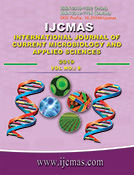


 National Academy of Agricultural Sciences (NAAS)
National Academy of Agricultural Sciences (NAAS)

|
PRINT ISSN : 2319-7692
Online ISSN : 2319-7706 Issues : 12 per year Publisher : Excellent Publishers Email : editorijcmas@gmail.com / submit@ijcmas.com Editor-in-chief: Dr.M.Prakash Index Copernicus ICV 2018: 95.39 NAAS RATING 2020: 5.38 |
The laboratory experiment was conducted at RARI, Durgapura during rabi 2017 to find out the toxicity of insecticides, bio-pesticides & plant product against H. armigera were reared on gram leaves and pods as well as on artificial diets. The nucleus culture of H. armigera was maintained in the laboratory under controlled conditions (26 _+2°C and 80 +- 5 percent RH). The 12 days old larvae of H. armigera use as a test insect by residue film method for bioassay. Various concentration of treatments were prepare and mortality data obtained were corrected using Abbot’s formula (Abbott’s 1925) The treatments were divided into three categories viz., insecticides, bio- pesticides and plant products. The result shows that, the LC 50 value of Quinalphos was (0.054005%) shows its superiority over the acephate with LC 50 of 0.227715 per cent against H. armigera. Among the bio-pesticides the LC 50 value of spinosad (1.0256087%) which was lower than the b.t.k. (3.86555%) and diflubenzuron (5.37584%), so it was most effective as compared to other bio-pesticides. Among various plant products the LC 50 value of neem oil (1.5738827%) and eucalyptus oil (3.2800034%) thus; neem oil shows its superiority over other plant products. So order of toxicity of different insecticides, bio-pesticides and plant products as under: Insecticides: Quinalphos > Acephate, Bio-pesticides: Spinosad > B.t.k. > Difiubnzuron, Plant product: Neem oil > Karanj oil > Mahua oil > Eucalyptus oil.
 |
 |
 |
 |
 |